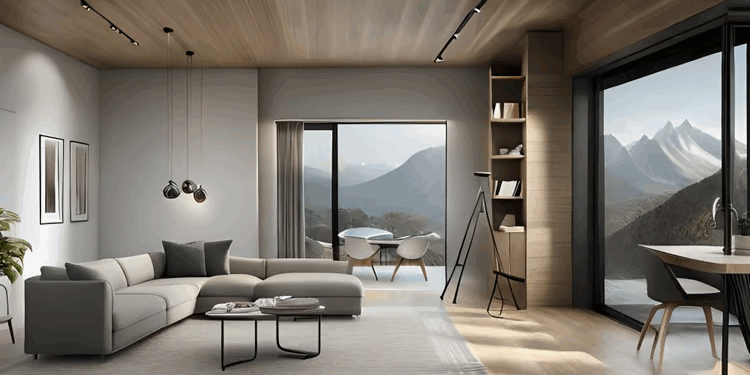
Embark on a journey into the world of architectural interior design 2, where creativity meets functionality in a harmonious blend. This guide delves deep into the intricate details of design principles, elements, space planning, sustainable practices, and current trends, offering a rich tapestry of knowledge for enthusiasts and professionals alike.
Delve into the realm of architectural interior design 2 and discover the artistry and innovation that define this dynamic field.
Overview of Architectural Interior Design
Architectural interior design is a discipline that focuses on creating functional and aesthetically pleasing spaces within buildings. It involves the design and arrangement of interior spaces to enhance the overall experience of the occupants. The fundamental principles of architectural interior design include considerations such as space planning, lighting, materials, colors, and textures.
Role of Architectural Interior Design
Architectural interior design plays a crucial role in transforming a space into a harmonious and functional environment. By considering the needs and preferences of the inhabitants, designers can create spaces that not only look beautiful but also serve their intended purpose effectively.
For example, a well-designed interior can improve productivity in a workspace, promote relaxation in a residential setting, or enhance the customer experience in a retail store.
Examples of Famous Architectural Interior Design Projects
- The Louvre Pyramid in Paris, designed by I.M. Pei, seamlessly integrates modern architecture with the historical Louvre Museum, creating a stunning entrance that complements the surrounding buildings.
- The Guggenheim Museum in Bilbao, designed by Frank Gehry, features a unique and dynamic interior space that showcases a bold use of materials and shapes, revolutionizing museum design.
- The Burj Al Arab in Dubai, designed by Tom Wright, is known for its luxurious and opulent interior design, which reflects the grandeur and extravagance of the hotel's overall architecture.
Elements of Architectural Interior Design
Architectural interior design encompasses various key elements that play a crucial role in creating a harmonious and aesthetically pleasing space. These elements include lighting, color schemes, furniture, and materials.
Lighting
Lighting is a fundamental element in architectural interior design as it not only illuminates the space but also sets the mood and ambiance. Designers use a combination of natural and artificial lighting to highlight architectural features, create focal points, and enhance the overall atmosphere of the room.
Color Schemes
Color schemes are essential in interior design as they can evoke certain emotions and create different spatial effects. Designers carefully choose colors to complement the furniture, materials, and overall theme of the space. They use color to establish a cohesive and inviting environment.
Furniture
The selection of furniture is crucial in interior design as it contributes to the functionality and aesthetics of the space. Designers choose furniture pieces that not only serve a practical purpose but also enhance the design concept. The arrangement and placement of furniture can also affect the flow and usability of the space.
Materials
The choice of materials, such as wood, metal, glass, and textiles, greatly influences the look and feel of a space. Architectural interior designers select materials that are not only visually appealing but also durable and sustainable. The use of different textures and finishes can add depth and character to the design.
Importance of Space Planning
Space planning plays a crucial role in architectural interior design as it involves organizing and arranging interior spaces in a way that enhances both the functionality and aesthetics of a space. Effective space planning can transform a room or building into a more efficient, comfortable, and visually appealing environment.
Techniques for Optimizing Space Utilization
- Use multipurpose furniture: Incorporating furniture pieces that serve multiple functions can help maximize space utilization in smaller rooms.
- Utilize vertical space: Installing shelves, cabinets, or storage units vertically can make use of often underutilized wall space.
- Consider traffic flow: Ensuring there are clear pathways and circulation throughout a space is essential for optimizing functionality and avoiding overcrowding.
- Scale and proportion: Properly scaling furniture and decor elements to fit the size of a room can contribute to a balanced and harmonious design.
Impact of Space Planning on Functionality and Flow
Space planning directly influences how a space is used and experienced
Sustainable Design Practices in Architectural Interior Design
When it comes to architectural interior design, sustainability has become a crucial aspect in creating spaces that are not only aesthetically pleasing but also environmentally friendly. Sustainable design practices focus on reducing the negative impact on the environment while promoting healthier living spaces for occupants.
Integration of Eco-Friendly Materials
One way to incorporate sustainability into architectural interior design is by using eco-friendly materials. These materials are sourced responsibly and have a lower environmental impact compared to traditional materials. Examples include reclaimed wood, bamboo, recycled glass, and low VOC paints.
Energy-Efficient Solutions
Another key aspect of sustainable design is the integration of energy-efficient solutions. This can involve using energy-efficient lighting, appliances, and HVAC systems to reduce energy consumption and lower utility costs. Additionally, incorporating natural lighting and ventilation can help decrease the reliance on artificial lighting and mechanical systems.
Benefits of Sustainability in Design
By incorporating sustainable practices into architectural interior design projects, designers can create healthier and more efficient spaces for occupants. Benefits include improved indoor air quality, reduced energy consumption, lower operating costs, and a smaller carbon footprint. Sustainable design not only benefits the environment but also enhances the overall well-being of the people using the space.
Trends in Architectural Interior Design
Architectural interior design is constantly evolving, with new trends shaping the way spaces are designed and utilized. These trends are influenced by various factors, including technological advancements, changing consumer preferences, and environmental considerations.
Incorporation of Biophilic Design
One major trend in architectural interior design is the incorporation of biophilic design principles. This approach focuses on connecting people with nature by integrating natural elements like plants, natural light, and organic materials into interior spaces. Biophilic design has been shown to improve well-being, productivity, and overall satisfaction in occupants.
Integration of Smart Home Technology
Another significant trend is the integration of smart home technology into interior design. From smart lighting and thermostats to voice-activated assistants and automated systems, technology is revolutionizing how spaces are controlled and experienced. This trend not only enhances convenience but also improves energy efficiency and sustainability.
Adaptive Reuse and Sustainable Materials
Architectural interior design is also seeing a rise in adaptive reuse projects and the use of sustainable materials. Designers are repurposing existing buildings and structures to create unique and environmentally friendly spaces. The use of recycled materials, energy-efficient systems, and eco-friendly finishes is becoming more prevalent in modern interior design projects.
Minimalism and Scandinavian Design Aesthetics
Minimalism and Scandinavian design aesthetics continue to influence architectural interior design trends. Clean lines, neutral colors, and a focus on functionality are key elements of these design styles. Many designers are embracing simplicity and minimalistic approaches to create timeless and elegant interiors that prioritize comfort and functionality.
Ending Remarks
As we conclude our exploration of architectural interior design 2, we are left with a profound understanding of its transformative power in shaping the spaces we inhabit. From sustainable practices to cutting-edge trends, the future of architectural interior design 2 is indeed filled with endless possibilities and creative opportunities.
User Queries
What are some key elements of architectural interior design 2?
Key elements include lighting, color schemes, furniture, and materials, which are skillfully integrated to create cohesive and visually appealing spaces.
How does space planning impact architectural interior design 2?
Space planning is crucial for optimizing functionality and flow within interior spaces, ensuring efficient utilization of space for various purposes.
Why is sustainable design important in architectural interior design 2?
Sustainable design promotes eco-friendly practices and energy-efficient solutions, contributing to a more environmentally conscious approach in design projects.













